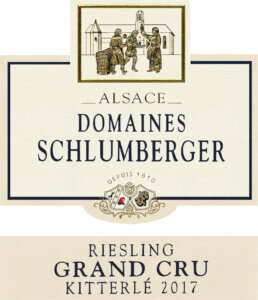History
Ranked among the best wines in the world, the Riesling is one of Alsace’s biggest successes. Introduced in the 15th century, and originating from the Orleanois region, it is different from its German counterpart and from the numerous Riesling, which can now be found a little all over the world. A late-ripening grape variety, it continues to ripen at low temperatures, but gives marvelous results when there is a sunny, dry, late summer. First distinguished in 1699, Kitterlé has always had an exceptional reputation. Already protected in the middle ages, it has been sold under its own name since 1830.
Location
This volcanic-sandstone plot is on a unique site, on a steeply sloping rocky outcrop facing three ways (south-west, south and south-east). The light, sandy soil, which is kept back by huge dry stonewalls, only gives very low yields (25 to 35 hl/ha).
Wine-making
The grapes are handpicked and whole bunches are pressed. There is static settling of the lees. The wine is fermented in temperature-controlled tuns, followed by raising on the less for 8 months.
Gastronomy
Ideal to accompany a cuisine based on the sea, it can be associated with stuffed mussels as in the French city of Sète, a nage of crustacean and shellfish in a crust, a green tea risotto with lobster medallions or a goat’s cheese, such as the Pouligny Saint Pierre… Serve at 12°C.
This wine goes well with
- Hors d'œuvre / Salad
- Seafood
- Pasta
- Raw and smoked fishes
- Cocked fishes
- Soft Cheese
- Asian food
- Sweety / Salty
Tasting
The robe is lemon yellow with green reflections of medium intensity. The disk is bright, limpid and transparent. The wine shows youth.
The nose is marked, pleasant and intense. We perceive a dominant of scents of delicate vegetal, white flowers and citrus fruits (lemon zest and lime).
The airing enhances the previous scents and reveals a mineral touch of naphtha, slightly smoked. Ripe and complex, the fragrance profile gives prominence to the terroir. It requires time to assert itself.
The onset in the mouth is moderately ample, slender. The alcohol support is balanced. The wine evolves on a medium with a frank liveliness, marked by a sparkling note. The range of flavours is in line with that of the nose, still dominated by citrus fruits (clementine, lime), white flowers, spices (ginger) and this slight yet complex smoked mineral touch of naphtha. We can taste a delicate bitterness. The finish has a long length, 5-6 caudalies, as well as a frank and persistent liveliness. The profile is pure and crystalline, embellished by the terroir character. It requires time to open.
Comments by Pascal Leonetti – January 2019
“Best Sommelier of France 2006”















